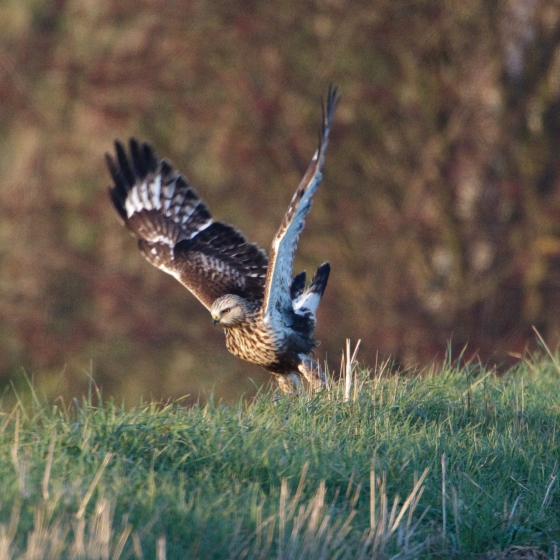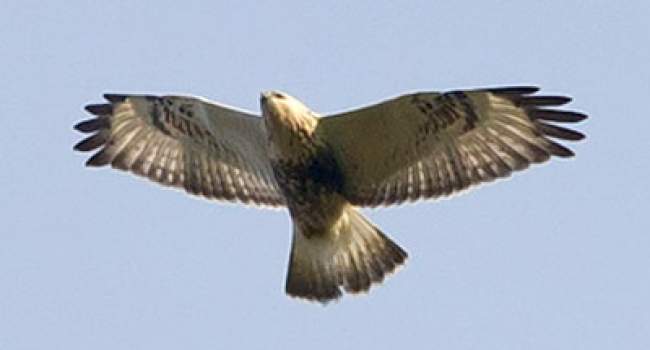Rough-legged Buzzard
Buteo lagopus (Pontoppidan, 1763)
RF
 ROLBU
ROLBU  2900
2900

Family: Accipitriformes > Accipitridae

This species is exclusively a winter bird in Britain, visiting our shores from a breeding range that stretches from Norway east across Asia and North America.
Rough-legged Buzzards arrive in very small numbers in late autumn, favouring the English east coast and the northern isles of Scotland. The numbers arriving fluctuate markedly from year to year, and are probably dependent on feeding conditions in the breeding range.
Rough-legged Buzzards can be confused with pale morphs of their very common cousin the Buzzard, but a blackish-brown belly contrasting with pale head and neck, and a clear white base to the tail are reliable field features.
Identification
Rough-legged Buzzard identification is often difficult. The following article may help when identifying Rough-legged Buzzard.
Identifying Common Buzzard and Rough-legged Buzzard

In winter, Honey-buzzard is replaced by Rough-legged Buzzard as the key confusion species with Common Buzzard. This identification video talks about the features to focus to help make it a little easier to identify this sometimes difficult pair.
Develop your bird ID skills with our training courses
Our interactive online courses are a great way to develop your bird identification skills, whether you're new to the hobby or a competent birder looking to hone your abilities.
Browse training coursesStatus and Trends
Population size and trends and patterns of distribution based on BTO surveys and atlases with data collected by BTO volunteers.
CONSERVATION STATUS
This species can be found on the following statutory and conservation listings and schedules.
DISTRIBUTION
Rough-legged Buzzards are scarce but regular autumn and winter visitors to the British east coast. During 2007–11 most records were from the eastern half of England, from Yorkshire to Kent, and on the Northern Isles.
Occupied 10-km squares in UK
| No. occupied in winter | 125 |
| % occupied in winter | 4.1 |
European Distribution Map
DISTRIBUTION CHANGE
| % change in range in winter (1981–84 to 2007–11) | +15.1% |
SEASONALITY
Rough-legged Buzzards are scarce winter visitors, with a pulse of migrants in late autumn in some years.

Movement
Information about movement and migration based on online bird portals (e.g. BirdTrack), Ringing schemes and tracking studies.
An overview of year-round movements for the whole of Europe can be seen on the EuroBirdPortal viewer.
RINGING RECOVERIES
View a summary of recoveries in the Online Ringing Report.
Foreign locations of birds ringed or recovered in Britain & Ireland

Biology
Lifecycle and body size information about Rough-legged Buzzard, including statistics on nesting, eggs and lifespan based on BTO ringing and nest recording data.
BIOMETRICS
Sample sizes are too small to report Biometrics for this species.
Feather measurements and photos on featherbase 
CODES & CLASSIFICATION
Field Codes 
|
2-letter: RF | 5-letter code: ROLBU | Euring: 2900 |
For information in another language (where available) click on a linked name
Links to more studies from ConservationEvidence.com
- Competitive behaviour and feeding rate in a reintroduced population of griffon vultures Gyps fulvus
- Calcium supplementation of breeding birds: directions for future research
- Growth and demography of a re-introduced population of white-tailed eagles Haliaeetus albicilla
Read more studies about Rough-legged Buzzard on Conservation Evidence >
Would you like to search for another species?









Share this page